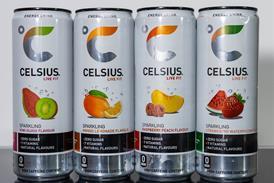There’s nothing quite like a fragrant bouquet to lift the spirits. And done properly, flowers can lift profits too, says Jo de Mille.
Flowers are what you might call an ‘emotional’ product - they don’t need shelf-barkers, walkers or any other form of marketing. The plants speak for themselves. Customers are tempted to buy them in the same way they might fall in love with a puppy in the local pet shop - it’s all about first impressions. Maintenance and presentation are therefore the buzzwords. However beautiful the colour or classy the packaging, if the flowers are dead - or dying - they won’t sell. But as UK director of the Flower Council of Holland Jo Read says: “The c-store retailers who are taking the time to present them well are getting very good returns on them.” He believes the changing profile of c-stores will provide a big market opportunity for retailers, as the increasing emphasis on fresh in c-stores means people no longer see them solely as somewhere to pick up a tin of beans or pint of milk. At the same time, convenience is all about everyday items, and flowers are increasingly becoming a part of this, as no ‘perfect home’ image is complete without the vase of blooms on the table. According to the latest Mintel report (September 2004) the total market for cut flowers and house plants grew 60% between 1999 and 2004 to reach an estimated value of just over £1.55bn. But for those of you whose fingers aren’t even the faintest shade of green, retailer Dean Holborn reassuringly says that you don’t need to know your daffodils from your dahlias to start selling flowers. Dean owns D&D Holborn, in Redhill, Surrey and has been selling flowers for the past 16 years. As he explains: “Flowers are like any other category. Before stocking fruit you don’t necessarily know your Braeburn from your Discovery apple, but you quickly start to recognise the different types.” And let’s be honest, flowers bought in c-stores are generally impulse purchases - grabbing a bouquet on the way to a friend’s, or picking up a simple bouquet to brighten up the home for the weekend. So, for instance, if a male customer is planning to send a pricey bouquet to lure back an ex, his first point of call is going to be the florist, not a c-store. DISTRESS PURCHASES
As the Flowers and Plants Association’s Kate Kenyon points out: “Open any fashion or homes magazine and you will see examples of the current vintage or retro trend. The colours are dusky pinks, creams, whites and muted colours. This extends to the flower market too.” She says these trends aren’t necessarily suitable for the c-store market, which is more about catering for males making distress purchases or people who want value for money rather than the ornate bouquets they can get from a florist. Dean says this certainly rings true in his store: “We do get men who run in on the morning of their anniversary for flowers and a card before the wife has woken up. We also get lots of women coming in buying for friends or for themselves - it’s a real mixture.” He agrees purchases can be price-driven, with customers after the best value for money bouquet. His top sellers are mixed bouquets, which retail at around £4.75, followed by spray carnations (around £4.75 a bunch) and lilies, since they are timeless flowers which last for up to two weeks. He also offers seasonal bunches such as daffodils for 50p in springtime, which are very popular with his customers. His bouquets are delivered every Thursday by Occasionally Yours, a supplier which delivers to independent retailers. In a week Dean can expect to make around £150 from sales of flowers. It’s not a massive amount, he admits, but there are other benefits. For example, stocking the flowers outside the store acts as a marketing tool for other categories in-store and tempts customers inside. He says: “The best thing about selling flowers is that everyone likes them, even if men won’t admit to it! They are homely and appeal to the senses, making your store look more attractive.” WATCH THE WEATHER
Dean’s biggest worry, however, is those occasional hot and sticky summer days when the flowers can perish rapidly. He urges retailers to watch for the weather forecast, saying: “Flowers are like any other perishable category. When it’s very hot, we make sure the buckets are always full of water and that the flowers aren’t in direct sunlight.” Unfortunately, Dean can’t move the flowers inside, as there’s not enough room. If you do merchandise flowers inside, make sure they’re away from the radiator or refrigeration unit as the hot air will make them wilt. While most c-stores will sell bunches of flowers in cellophane wrapping, D&D Holborn has always rewrapped them in a flower wrapping paper at the point of sale.
Dean explains: “We’ve always wrapped the flower at the till. I believe it’s the finished article that counts, and wrapping makes the flowers look more presentable - it’s the sort of thing a florist would do. “The staff don’t like it, because it takes a bit of time and some say it is too complicated. But I insist. I show them how to do it.”
Dean admits there is a degree of wastage, anything up to 30% in a bad week, but in other weeks he can sell out completely. If a customer has just had a baby, the store has a tradition of giving them a free congratulatory bouquet. The only time flowers need to be actively marketed are special occasions such as Valentine’s Day, Mothers’ Day, Easter, Christmas and, if you are English and feeling particularly patriotic, St George’s Day. And it’s worth doing it properly, because from Dean’s experience, flower sales increase three to four-fold during the week of these occasions.
Retailer Mair Evans, who owns three Londis stores in Wales, says customers care more about finding the right bunch of flowers than the cost. She sells an “unbelievable amount” of flowers around Valentines Day, which she describes as a hot spot for flower sales and a welcome boost for turnover during normally quiet February days. For the more affluent (or generous) customers she sells a selection of hand-tied luxury bunches, the most expensive retailing at £30. Quite a few of her customers are prepared to spend this sort of money for a special occasion. This Valentine’s Day, Mair ran a promotion linking a bottle of chardonnay and Ferrero Rocher when bought with a bunch of flowers. Her stores sell so many flowers they compete with the local florists. Mair concludes: “Where the multiples lead, the convenience store needs to follow. The customer expects a one-stop shop and flowers are part of the complete package.”
Flowers are what you might call an ‘emotional’ product - they don’t need shelf-barkers, walkers or any other form of marketing. The plants speak for themselves. Customers are tempted to buy them in the same way they might fall in love with a puppy in the local pet shop - it’s all about first impressions. Maintenance and presentation are therefore the buzzwords. However beautiful the colour or classy the packaging, if the flowers are dead - or dying - they won’t sell. But as UK director of the Flower Council of Holland Jo Read says: “The c-store retailers who are taking the time to present them well are getting very good returns on them.” He believes the changing profile of c-stores will provide a big market opportunity for retailers, as the increasing emphasis on fresh in c-stores means people no longer see them solely as somewhere to pick up a tin of beans or pint of milk. At the same time, convenience is all about everyday items, and flowers are increasingly becoming a part of this, as no ‘perfect home’ image is complete without the vase of blooms on the table. According to the latest Mintel report (September 2004) the total market for cut flowers and house plants grew 60% between 1999 and 2004 to reach an estimated value of just over £1.55bn. But for those of you whose fingers aren’t even the faintest shade of green, retailer Dean Holborn reassuringly says that you don’t need to know your daffodils from your dahlias to start selling flowers. Dean owns D&D Holborn, in Redhill, Surrey and has been selling flowers for the past 16 years. As he explains: “Flowers are like any other category. Before stocking fruit you don’t necessarily know your Braeburn from your Discovery apple, but you quickly start to recognise the different types.” And let’s be honest, flowers bought in c-stores are generally impulse purchases - grabbing a bouquet on the way to a friend’s, or picking up a simple bouquet to brighten up the home for the weekend. So, for instance, if a male customer is planning to send a pricey bouquet to lure back an ex, his first point of call is going to be the florist, not a c-store. DISTRESS PURCHASES
As the Flowers and Plants Association’s Kate Kenyon points out: “Open any fashion or homes magazine and you will see examples of the current vintage or retro trend. The colours are dusky pinks, creams, whites and muted colours. This extends to the flower market too.” She says these trends aren’t necessarily suitable for the c-store market, which is more about catering for males making distress purchases or people who want value for money rather than the ornate bouquets they can get from a florist. Dean says this certainly rings true in his store: “We do get men who run in on the morning of their anniversary for flowers and a card before the wife has woken up. We also get lots of women coming in buying for friends or for themselves - it’s a real mixture.” He agrees purchases can be price-driven, with customers after the best value for money bouquet. His top sellers are mixed bouquets, which retail at around £4.75, followed by spray carnations (around £4.75 a bunch) and lilies, since they are timeless flowers which last for up to two weeks. He also offers seasonal bunches such as daffodils for 50p in springtime, which are very popular with his customers. His bouquets are delivered every Thursday by Occasionally Yours, a supplier which delivers to independent retailers. In a week Dean can expect to make around £150 from sales of flowers. It’s not a massive amount, he admits, but there are other benefits. For example, stocking the flowers outside the store acts as a marketing tool for other categories in-store and tempts customers inside. He says: “The best thing about selling flowers is that everyone likes them, even if men won’t admit to it! They are homely and appeal to the senses, making your store look more attractive.” WATCH THE WEATHER
Dean’s biggest worry, however, is those occasional hot and sticky summer days when the flowers can perish rapidly. He urges retailers to watch for the weather forecast, saying: “Flowers are like any other perishable category. When it’s very hot, we make sure the buckets are always full of water and that the flowers aren’t in direct sunlight.” Unfortunately, Dean can’t move the flowers inside, as there’s not enough room. If you do merchandise flowers inside, make sure they’re away from the radiator or refrigeration unit as the hot air will make them wilt. While most c-stores will sell bunches of flowers in cellophane wrapping, D&D Holborn has always rewrapped them in a flower wrapping paper at the point of sale.
Dean explains: “We’ve always wrapped the flower at the till. I believe it’s the finished article that counts, and wrapping makes the flowers look more presentable - it’s the sort of thing a florist would do. “The staff don’t like it, because it takes a bit of time and some say it is too complicated. But I insist. I show them how to do it.”
Dean admits there is a degree of wastage, anything up to 30% in a bad week, but in other weeks he can sell out completely. If a customer has just had a baby, the store has a tradition of giving them a free congratulatory bouquet. The only time flowers need to be actively marketed are special occasions such as Valentine’s Day, Mothers’ Day, Easter, Christmas and, if you are English and feeling particularly patriotic, St George’s Day. And it’s worth doing it properly, because from Dean’s experience, flower sales increase three to four-fold during the week of these occasions.
Retailer Mair Evans, who owns three Londis stores in Wales, says customers care more about finding the right bunch of flowers than the cost. She sells an “unbelievable amount” of flowers around Valentines Day, which she describes as a hot spot for flower sales and a welcome boost for turnover during normally quiet February days. For the more affluent (or generous) customers she sells a selection of hand-tied luxury bunches, the most expensive retailing at £30. Quite a few of her customers are prepared to spend this sort of money for a special occasion. This Valentine’s Day, Mair ran a promotion linking a bottle of chardonnay and Ferrero Rocher when bought with a bunch of flowers. Her stores sell so many flowers they compete with the local florists. Mair concludes: “Where the multiples lead, the convenience store needs to follow. The customer expects a one-stop shop and flowers are part of the complete package.”


























No comments yet